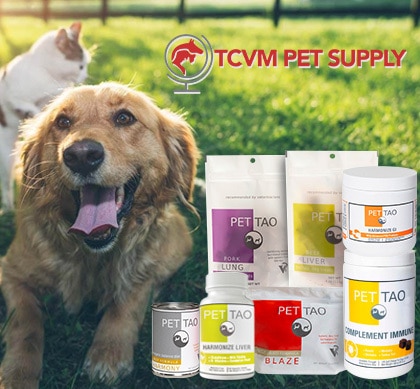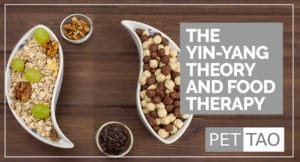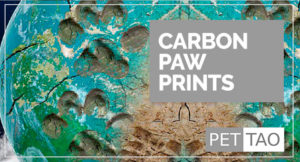Why Feed a Special Cushing’s Diet?
Cushing’s disease is a condition occurring when a dog’s adrenal glands produce too much of certain hormones.
The medical term for Cushing’s disease is hyperadrenocorticism.
Dogs suffering from Cushing’s disease go through three basic stages: early-stage, mid-stage, and late-stage.
Feeding the appropriate TCVM diet during each stage energetically balances your dog.
Being energetically balanced will make your dog feel much better and help alleviate symptoms associated with Cushing’s disease.
The information below is specific to late-stage Cushing’s Disease.
Signs of Late-Stage Dog Cushing’s Disease
When a dog enters the later stages of Cushing’s disease, obvious signs and symptoms appear.
Clinical signs of late-stage dog Cushing’s disease are:
- Enlarged palpable liver or spleen
- Depression, lethargy, exercise intolerance
- Poor hair coat
- Dilute urine and excessive urination
- Cold ears, back, and abdomen
- Emaciation
What Is Yang Deficiency in Late-Stage Dog Cushing’s Disease?
For easier understanding, we categorize dogs suffering from late-stage
Cushing’s disease in the TCVM pattern of Yang Deficiency.
Not dogs in late-stage Cushing’s disease will have Yang Deficiency, but the majority will. To get an exact TCVM diagnosis of your dog’s energetic health, you need to see a TCVM-trained veterinarian.
Your TCVM vet will also explain in detail what your dog is experiencing and what to expect.
Food Recipe for Dogs in Late-Stage Cushing’s Disease
Use Eastern Food Therapy to energetically balance your dog and make him/her feel better.
Most dogs in late-stage Cushing’s disease need foods to tonify Yang.*
Nutritional Requirements
A nutritionally balanced canine diet for dogs with Cushing’s disease contains:
- 60% – 80% Protein – mostly from meat
- 20% – 40% Carbohydrates – from grains, vegetables, and fruit
- A minimum of 2% fat and a maximum of 16% fat
Special Requirements for Cushing’s Disease
Dogs with Cushing’s disease also often suffer from hyperlipidemia–too much fat in the blood.
To counteract hyperlipidemia, you must feed to lower the amount of circulating fats in the blood.
The best way to lower the amount of circulating fats is to keep the fat in your dog’s diet below 16%.
If you have trouble doing the math, you can use a nutrient counter like what’s available on Livestrong or FitBit websites. An easy way to keep the fat at a minimum is to use lean meat.
Be Careful With Treats!
You also need to be careful what treats you feed a dog with Cushing’s disease. The best treats for Cushing’s disease, freeze-dried organ meats, are naturally low in fat.
Use the list of foods below to create endless delicious recipe combinations for your furry friend!
Mix up the ingredients as needed to create a food that your dog loves.
Food List for Dogs in Late-Stage Cushing’s Disease
As mentioned earlier, most dogs in late-stage Cushing’s disease need foods to tonify Yang.*
Foods to Tonify Yang
- Lamb
- Venison
- Beef
- Kidneys
- Lamb
- Liver
- Chicken
- Chicken egg yolk
- Oats
- White rice
- Sweet potatoes
- Pumpkin
- Squash
- Ginger
- Turmeric
- Basil
- Thyme
- Apricots
- Blackberries
- Olive oil
Yang Tonic Food Recipe for Dogs with Late-Stage Cushing’s Disease
Using the most appropriate food list from above, mix and match your dog’s favorites from the list in the ratios shown below.
The basic guidelines are:
- 5 lbs from the “Meat/Protein Source” list
- 1 1/2 lbs from the “Vegetables/Fruits” list
- 1 1/2 lbs from “Grains/Beans/Starch” list
Sample Recipe
3 pounds meat
2 pounds organ meat (varied)
1-1 1/2 pounds of vegetables (see “vegetable” list above)
1 pound sweet potatoes
1/2 pound brown rice (cooked weight, or 1/2 cups dry brown rice + 1 cup water)
Note: Remember you want to keep fat between 2% and 16%, so choose lean cuts and remove excess fat from meats.
Directions:
Debone and chop meat and vegetables.
Place all ingredients in crockpot layering:
- Slow cooking root vegetables on bottom
- Meat in the middle
- Fast cooking items on top
Top with 1 cup water.
Cook on low for 4 hours.
In addition, add the following to your pet’s diet:
- One canine multivitamin per day
- Calcium supplement 50mg/kg of body weight (22mg/lb of body weight) per day. Some other good choices for calcium are eggshell powder or bone meal.
Feeding Schedule:
Feed 1.5 cups per 25 pounds of body weight twice daily
Make sure to give your dog a canine multivitamin while on this plan!
Monitor your pet’s weight. If an undesirable weight loss occurs, please contact your veterinarian immediately so that you can make an adjustment in the feeding/diet plan.
*Not dogs in late-stage Cushing’s disease will have Yang Deficiency, but the majority will. To get an exact TCVM diagnosis of your dog’s energetic health, you need to see a TCVM-trained veterinarian.
Powerful Tools for Dog Cushing’s Disease Health Challenges
There are many quick and easy changes you can make at home to help you give your dog an edge on easing Cushing’s disease challenges.
- Learn more about Cushing’s Disease.
- Try Home Cooking. Visit our Recipe Page, and scroll down to the recipes for dogs with Cushing’s disease. Often, home-cooking makes a huge difference in helping dogs feel better!
- Supplement with medicinal mushrooms. PET | TAO’s Complement Immune Mushroom Blend eases inflammatory response and immune system stress caused by Cushing’s.
- Try digestive enzymes and probiotics. PET | TAO’s Harmonize Gi boosts gut health, which in turn helps your dog better process all food nutrients. Improved gut health also boosts immunity and calms allergic response.
- Feed Freeze Dried Liver Treats. According to TCVM, as when Cushing’s disease is present there is almost always Liver Meridian involvement. Liver treats provide Liver Meridian support like as a glandular supplement (Western theory) and via 5-Element Theory (Eastern theory).
- Learn more about TCVM Herbal Remedies. Chinese medicine offers many amazing natural solutions for Cushing’s disease. A good example is:
Get A Phone Consultation with One of Our TCVM Veterinarians
Disclaimer
Please consult with your veterinarian and use personal judgment when cooking at home for your dog. Even though pet food recalls and the poor quality of some pet foods are a concern, many veterinarians voice concerns over homemade diets. Some vets feel that when fed exclusively, homemade diets may result in vitamin/mineral deficiencies that can adversely affect a pet’s health. If you choose to feed your dog a homemade diet, you must understand and meet your dog’s needs to stay healthy. Please share our recipe with your veterinarian. Your veterinarian can advise you on supplements for your pet’s individual situation. Monitor your dog’s health by observing his/her temperament, skin, coat, and waste. If you notice anything strange, contact your veterinarian immediately.








